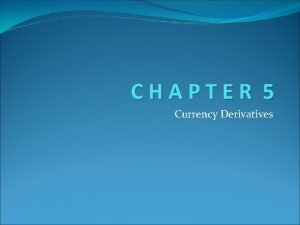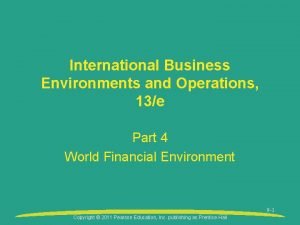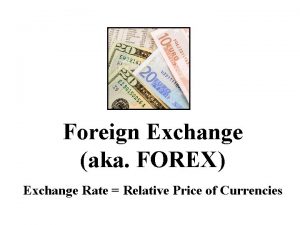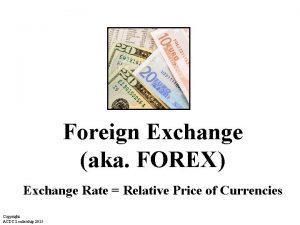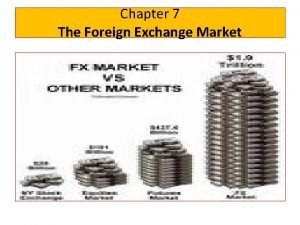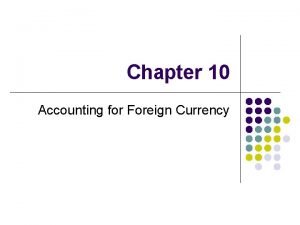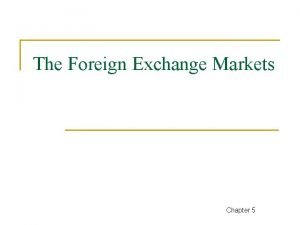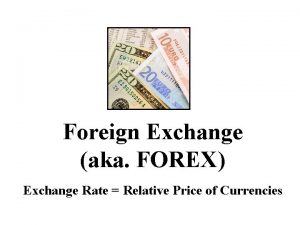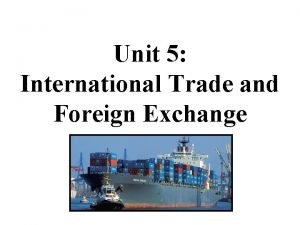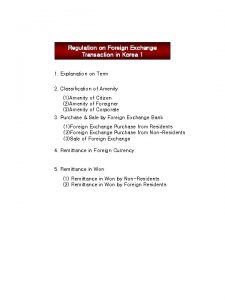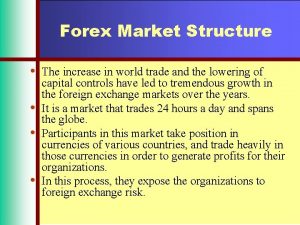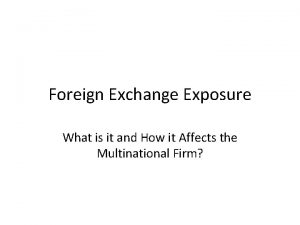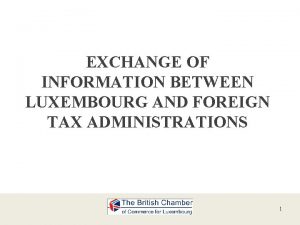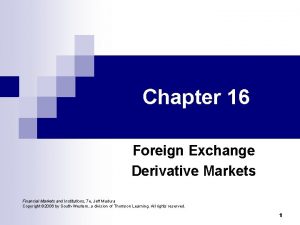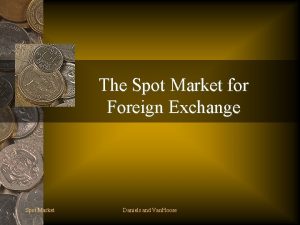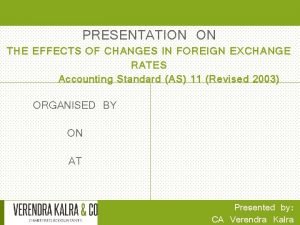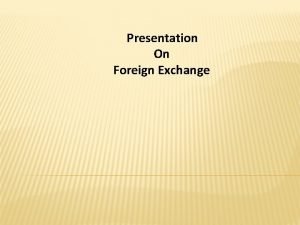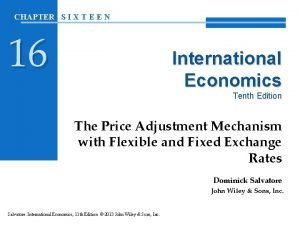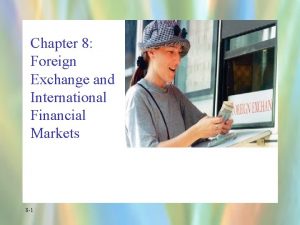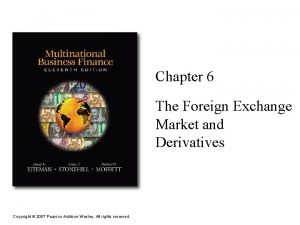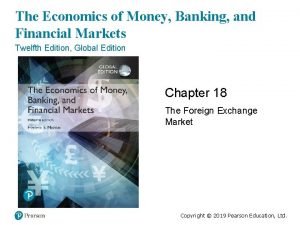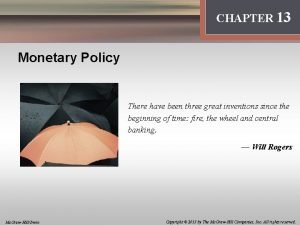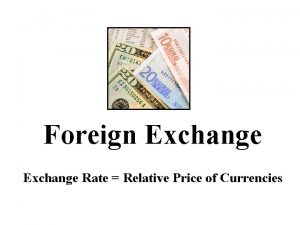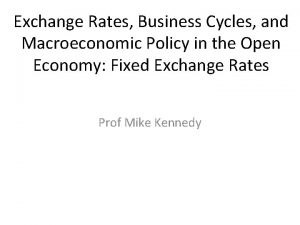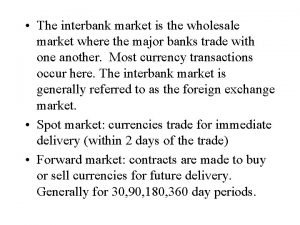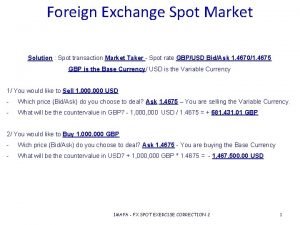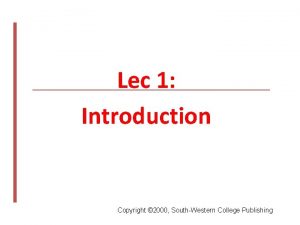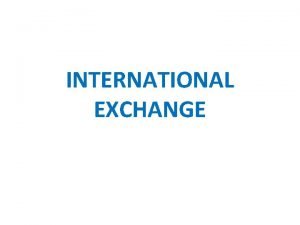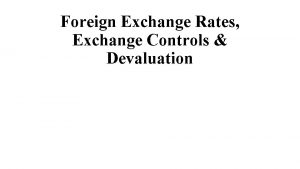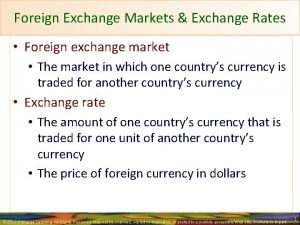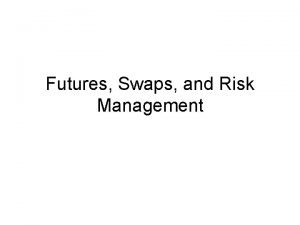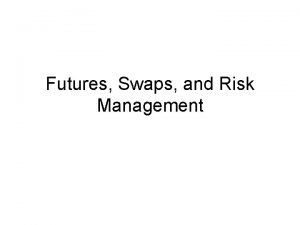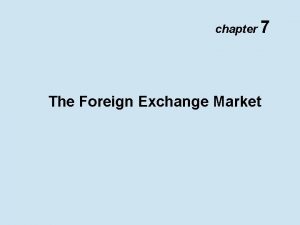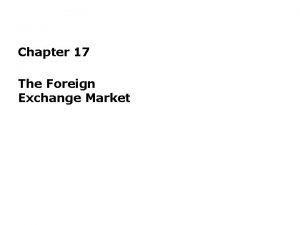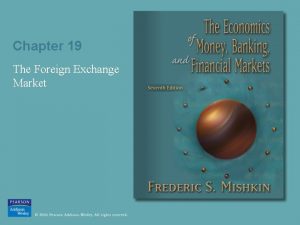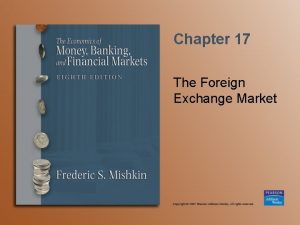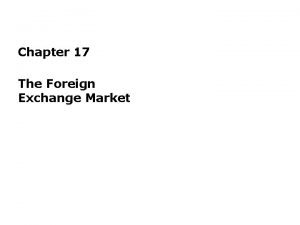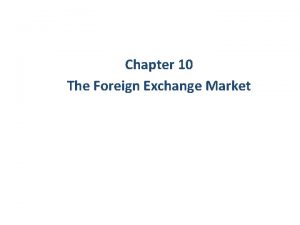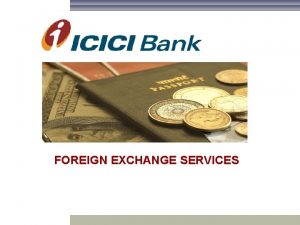Chapter 10 Foreign Exchange Futures 1 2004 SouthWestern















































- Slides: 47

Chapter 10 Foreign Exchange Futures 1 © 2004 South-Western Publishing

Outline l l l 2 Introduction Foreign exchange risk Forward rates Foreign currency futures Dealing with the exposure

Introduction l The capital markets across the globe have become one giant playing field – 3 The U. S. share of market capitalization is steadily declining as foreign markets develop

Foreign Exchange Risk l l l 4 Introduction FX risk and interest rates The concept of exposure FX risk from a business perspective FX risk from an investment perspective

Introduction 5 l Overseas investments and international business involve foreign exchange risk l A survey of corporate treasurers indicates that the primary corporate use of derivative assets is hedging foreign exchange exposure

Introduction (cont’d) l Foreign exchange risk is the risk of loss due to changes in the relative value of world currencies – 6 Modest changes in exchange rates can result in significant dollar differences

FX Risk and Interest Rates l l 7 Introduction The real rate of interest The inflation premium The risk premium

Introduction l Events in one industrial country affect the rest of the world – 8 Interest rates are often a good barometer of events like high unemployment, changes in economic policy, etc.

The Real Rate of Interest l The nominal interest rate (the stated rate) can be expressed as the sum of: – – – 9 The real rate An inflation premium and A risk premium

The Real Rate of Interest (cont’d) l The real rate reflects the rate of return investors demand for giving up the current use of funds – – – 10 Indicates people’s willingness to postpone spending their money Is not directly observable Hovers in the 3% to 4% range

The Inflation Premium l The inflation premium reflects how the general price level is changing – – 11 Measures how rapidly the money standard is losing its purchasing power In the past 75 years, U. S. inflation has averaged about 3. 2% annually

The Risk Premium l The risk premium is the component of interest rates that is most difficult to measure – – 12 Risk-averse investors expect to be compensated for risks they take The price of a risky security must reflect a risk premium to entice someone to buy it The magnitude of the risk premium depends on how much risk the security carries The higher the risk premium, the lower the price

The Concept of Exposure l l l 13 Introduction Accounting exposure Economic exposure

Introduction l Exposure is the extent to which you face foreign exchange risk l There are two general types of exposure: – – 14 Accounting exposure Economic exposure

Accounting Exposure l Accounting exposure is the exchange rate exposure that results when consolidated financial statements are prepared in a single currency l Two types of accounting exposure: – – 15 Transaction exposure Translation exposure

Accounting Exposure (cont’d) l Transaction exposure results from transactions involving the purchase or sale of goods or services with the price stated in foreign currency – – 16 Exists until the payable or receivable is liquidated E. g. , a U. S. importer must pay a European supplier in Swiss francs

Accounting Exposure (cont’d) l 17 Translation exposure results from translating foreign assets and liabilities into U. S. dollars on the consolidated balance sheet

Economic Exposure l Economic exposure measures the risk that the value of a security or a firm will decline due to an unexpected change in relative foreign exchange rates – – 18 Would reduce the value of the security or firm The most important type of exposure for security investors

FX Risk From A Business Perspective A Business Example of Economic Exposure An American importer agrees to purchase 400 Swiss overcoats at a price of CHF 1, 200 each, for a total of CHF 480, 000. The coats will take 3 months to produce, and the importer is to pay for them upon delivery. 19

FX Risk From A Business Perspective (cont’d) A Business Example of Economic Exposure (cont’d) Assume the following exchange rates exist today: Ø Ø 20 $ per CHF = $0. 8073 (direct quotation) CHF per $ = CHF 1. 2387 (indirect quotation)

FX Risk From A Business Perspective (cont’d) A Business Example of Economic Exposure (cont’d) If the importer paid for the coats today, each coat would cost the importer: CHF 1, 200 x $0. 8073/CHF = $968. 76 The importer is concerned that the U. S. dollar might weaken between now and coat delivery time. 21

FX Risk From A Business Perspective (cont’d) A Business Example of Economic Exposure (cont’d) 22 If the dollar strengthens and the value of the Swiss franc falls to $0. 7500, the cost of each coat will be: CHF 1, 200 x $0. 7500/CHF = $900. 00 If the dollar weakens to an exchange rate of $0. 9000, the cost of each coat will be: CHF 1, 200 x $0. 9000/CHF = $1, 080. 00

FX Risk From An Investment Perspective An Investment Example of Economic Exposure You just placed an order with your broker to purchase 10, 000 shares of Kangaroo Lager, trading on the Sydney Stock Exchange. You can currently purchase the shares for AUD 1. 45 apiece. The current exchange rate is $0. 5755/AUD. Thus, the shares cost you: 23 10, 000 x AUD 1. 45 x $0. 5755/AUD = $8, 344. 75

FX Risk From An Investment Perspective (cont’d) An Investment Example of Economic Exposure (cont’d) You hold the Kangaroo shares for six months, at which time the shares sell for AUD 1. 95. This is a return of (1. 95 – 1. 45)/1. 45 = 34. 5% 24

FX Risk From An Investment Perspective (cont’d) An Investment Example of Economic Exposure (cont’d) In six months, the exchange rate is $0. 5500. If you were to sell the shares, you would receive: 10, 000 x AUD 1. 95 x $0. 5500/AUD = $10, 725. 00 This is a return on investment of ($10, 725. 00 - $8, 344. 75)/$8, 344. 75 = 28. 52% 25

Forward Rates l l l 26 Introduction Purchasing power parity Interest rate parity

Introduction 27 l The spot exchange rate is the current exchange rate for two currencies l The forward exchange rate is a contractual rate between a commercial bank and a client for the future delivery of a specified quantity of foreign currency

Introduction (cont’d) l 28 Forward exchange rates are normally quoted on the basis of one, two, three, six, and twelve months

Introduction (cont’d) l The forward rate is an unbiased estimate of the future spot rate foreign exchange – 29 E. g. , if forward rates show that the dollar is expected to strengthen against the Swiss franc, it would make sense to delay paying Swiss francs as long as possible

Introduction (cont’d) l 30 The difference between the forward and spot rates can be quoted as an annual premium or discount:

Purchasing Power Parity l Purchasing power parity is an arbitragebased idea that in a world of perfect markets, the same good should sell for the same price in different countries – 31 Assumes there are no trade barriers, no taxes, etc.

Purchasing Power Parity (cont’d) 32 l Unexpected inflation causes the value of the home currency to fall l Differentials in international inflation rates can be a source of foreign exchange risk

Interest Rate Parity l Interest rate parity states that differences in national interest rates will be reflected in the currency forward market – 33 Two securities of similar risk and maturity will show a difference in their interest rates equal to the forward premium or discount, but with the opposite sign

Interest Rate Parity (cont’d) l 34 According to interest rate parity:

Interest Rate Parity (cont’d) Computing Implied Foreign Interest Rates It is now January 2, 2004. The six-months forward rate for the British pound is £ 0. 5658/$; the spot rate is £ 0. 5576/$. Also, the six-month T-bill rate is 1. 01%. What is the implied British 6 -month interest rate based on the interest rate parity relationship? 35

Interest Rate Parity (cont’d) Computing Implied Foreign Interest Rates (cont’d) The implied British 6 -month interest rate is 3. 96%: 36 The actual UK rate in early 2004 was 3. 90%.

Foreign Currency Futures l l 37 Introduction Pricing of foreign exchange futures contracts

Introduction l Foreign currency futures contracts were the first financial futures traded on exchanges in the U. S. – l 38 Began trading at the Chicago Mercantile Exchange in 1972 Foreign currency futures were quickly recognized as very effective ways to deal with foreign exchange risk

Pricing of Foreign Exchange Futures Contracts l Futures prices are a function of – – l 39 The spot price The cost of carrying the particular asset or financial instrument For foreign currency futures, the cost of holding one currency rather than another is an opportunity cost measured by differences in interest rates

Pricing of Foreign Exchange Futures Contracts (cont’d) l 40 A basic pricing model:

Pricing of Foreign Exchange Futures Contracts (cont’d) Pricing A Foreign Currency Futures Contract Example In the Land of Leptonia interest rates are 10. 00%, and the current dollar price of a Lepton is $0. 4817. The current Eurodollar deposit rate is 7. 50%. For how much should a 90 -day futures contract on Lepton’s sell? 41

Pricing of Foreign Exchange Futures Contracts (cont’d) Pricing A Foreign Currency Futures Contract Example (cont’d) Using the equation: The futures price for Leptons should be less than their cost in the spot market. This is because Leptonia’s interest rates are 2. 5% higher than the U. S. rate. 42

Dealing With the Exposure l l 43 Introduction Ignore the exposure Reduce or eliminate the exposure Hedge the exposure

Introduction l The portfolio manager needs to decide whether to: – – – 44 Ignore the exposure, Eliminate the exposure, or Hedge the exposure

Ignore the Exposure 45 l Investors may be aware of economic exposure but accept it as a fact of life l Ignoring the exposure may be appropriate if the dollar amount of the exposure is relatively small l Ignoring the exposure may be appropriate if the dollar is expected to depreciate

Reduce or Eliminate the Exposure 46 l Amounts to selling the foreign security or reducing the size of the position l May be appropriate if the dollar is expected to appreciate dramatically

Hedge the Exposure l Involves taking a position in the market that offsets another position – – 47 Hedging foreign exchange risk is also called covering the risk Hedging can be done in the forward market or the futures market
 Too foreign for home too foreign for here
Too foreign for home too foreign for here Saham samsung
Saham samsung Currency futures contracts sold on an exchange:
Currency futures contracts sold on an exchange: Futures exchange
Futures exchange Futures exchange
Futures exchange Foreign exchange process
Foreign exchange process Foreign exchange tourism grade 12
Foreign exchange tourism grade 12 Foreign exchange shifters
Foreign exchange shifters 4 forex shifters
4 forex shifters Kinds of foreign exchange market
Kinds of foreign exchange market Foreign currency accounting
Foreign currency accounting Objective of foreign exchange
Objective of foreign exchange Xlri student exchange
Xlri student exchange 4 shifters of foreign exchange
4 shifters of foreign exchange International trade and foreign exchange
International trade and foreign exchange Foreign exchange transaction regulation korea
Foreign exchange transaction regulation korea Markets
Markets Market structure definition forex
Market structure definition forex Types of foreign exchange exposure
Types of foreign exchange exposure Christophe joosen
Christophe joosen Foreign exchange means
Foreign exchange means Foreign exchange derivative
Foreign exchange derivative Spot market in foreign exchange market
Spot market in foreign exchange market Integral and non integral foreign operations
Integral and non integral foreign operations Foreign exchange market slideshare
Foreign exchange market slideshare Exchange rate meaning in maths literacy
Exchange rate meaning in maths literacy Structure of foreign exchange market
Structure of foreign exchange market Foreign exchange market features
Foreign exchange market features Salient features of foreign exchange management act 1999
Salient features of foreign exchange management act 1999 Stability of foreign exchange market
Stability of foreign exchange market Foreign exchange and international financial markets
Foreign exchange and international financial markets Foreign exchange market example
Foreign exchange market example Wise foreign exchange program
Wise foreign exchange program Foreign exchange market
Foreign exchange market Foreign exchange market graph
Foreign exchange market graph Exchange rate graph
Exchange rate graph Foreign exchange market
Foreign exchange market Foreign exchange forward contract
Foreign exchange forward contract Foreign exchange worksheet
Foreign exchange worksheet Foreign exchange graph
Foreign exchange graph Interbank wholesale
Interbank wholesale Foreign exchange exposure
Foreign exchange exposure Spot market exchange
Spot market exchange Southwestern community college
Southwestern community college Southwestern college publishing
Southwestern college publishing Southwest province kappa psi
Southwest province kappa psi Southwestern college publishing
Southwestern college publishing Southwestern college cincinnati ohio
Southwestern college cincinnati ohio


